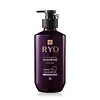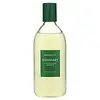What's inside
What's inside
 Key Ingredients
Key Ingredients

 Benefits
Benefits

 Concerns
Concerns

 Ingredients Side-by-side
Ingredients Side-by-side

Water
Skin ConditioningSodium Laureth Sulfate
CleansingAmmonium Lauryl Sulfate
CleansingGlycerin
HumectantCocamide Mea
EmulsifyingParfum
MaskingDisodium Laureth Sulfosuccinate
CleansingLauryl Hydroxysultaine
CleansingCaffeine
Skin ConditioningPPG-3 Caprylyl Ether
SolventAlcohol Denat.
AntimicrobialPhenoxyethanol
PreservativeSodium Benzoate
MaskingCetyl Alcohol
EmollientMenthol
MaskingGuar Hydroxypropyltrimonium Chloride
Skin ConditioningCitric Acid
BufferingSodium Salicylate
PreservativeCaprylic/Capric Triglyceride
MaskingTrihydroxystearin
Skin ConditioningSodium Citrate
BufferingDicaprylyl Ether
EmollientTetrasodium EDTA
Butylene Glycol
HumectantMalt Extract
Skin ProtectingDisodium EDTA
Linalool
PerfumingPEG-45m
HumectantGlyceryl Stearate
EmollientMentha Arvensis Leaf Extract
MaskingBenzyl Salicylate
PerfumingHexyl Cinnamal
PerfumingBenzyl Benzoate
AntimicrobialGeraniol
PerfumingAlpha-Isomethyl Ionone
PerfumingHydrolyzed Corn Starch
HumectantCaprylyl Glycol
EmollientPinus Densiflora Leaf Extract
Antimicrobial1,2-Hexanediol
Skin ConditioningDehydroacetic Acid
PreservativePanax Ginseng Extract
AntioxidantPanax Ginseng Root Extract
EmollientSilica
AbrasiveZingiber Officinale Root Extract
MaskingEthylhexylglycerin
Skin ConditioningTocopherol
AntioxidantOryza Sativa Extract
AbsorbentImperata Cylindrica Root Extract
Skin ConditioningScutellaria Baicalensis Root Extract
AstringentSesamum Indicum Seed Extract
Skin ConditioningLonicera Japonica Flower Extract
Skin ConditioningCalendula Officinalis Flower Extract
MaskingTribulus Terrestris Fruit Extract
Skin ConditioningCamellia Japonica Seed Oil
EmollientCamellia Sinensis Seed Oil
HumectantPEG-150 Pentaerythrityl Tetrastearate
EmulsifyingPPG-2 Hydroxyethyl Cocamide
EmulsifyingPolygonum Multiflorum Root Extract
Skin ConditioningWater, Sodium Laureth Sulfate, Ammonium Lauryl Sulfate, Glycerin, Cocamide Mea, Parfum, Disodium Laureth Sulfosuccinate, Lauryl Hydroxysultaine, Caffeine, PPG-3 Caprylyl Ether, Alcohol Denat., Phenoxyethanol, Sodium Benzoate, Cetyl Alcohol, Menthol, Guar Hydroxypropyltrimonium Chloride, Citric Acid, Sodium Salicylate, Caprylic/Capric Triglyceride, Trihydroxystearin, Sodium Citrate, Dicaprylyl Ether, Tetrasodium EDTA, Butylene Glycol, Malt Extract, Disodium EDTA, Linalool, PEG-45m, Glyceryl Stearate, Mentha Arvensis Leaf Extract, Benzyl Salicylate, Hexyl Cinnamal, Benzyl Benzoate, Geraniol, Alpha-Isomethyl Ionone, Hydrolyzed Corn Starch, Caprylyl Glycol, Pinus Densiflora Leaf Extract, 1,2-Hexanediol, Dehydroacetic Acid, Panax Ginseng Extract, Panax Ginseng Root Extract, Silica, Zingiber Officinale Root Extract, Ethylhexylglycerin, Tocopherol, Oryza Sativa Extract, Imperata Cylindrica Root Extract, Scutellaria Baicalensis Root Extract, Sesamum Indicum Seed Extract, Lonicera Japonica Flower Extract, Calendula Officinalis Flower Extract, Tribulus Terrestris Fruit Extract, Camellia Japonica Seed Oil, Camellia Sinensis Seed Oil, PEG-150 Pentaerythrityl Tetrastearate, PPG-2 Hydroxyethyl Cocamide, Polygonum Multiflorum Root Extract
Rosmarinus Officinalis Leaf Extract
AntimicrobialWater
Skin ConditioningPinus Densiflora Leaf Extract
AntimicrobialSodium Methyl Cocoyl Taurate
CleansingSodium Cocoyl Isethionate
CleansingSodium Methyl Oleoyl Taurate
CleansingLauryl Betaine
CleansingPropanediol
SolventSodium Chloride
MaskingErythritol
HumectantLauryl Glucoside
CleansingSalicylic Acid
MaskingRosmarinus Officinalis Leaf Oil
MaskingOcimum Basilicum Leaf Extract
Skin ConditioningOcimum Sanctum Leaf Extract
Skin ConditioningOriganum Vulgare Leaf Extract
Skin ConditioningZingiber Officinale Root Extract
MaskingBifida Ferment Lysate
Skin ConditioningLactobacillus Ferment Lysate
Skin ConditioningArginine
MaskingBiotin
AntiseborrhoeicPanthenol
Skin ConditioningCaffeine
Skin ConditioningPolyquaternium-10
Caprylyl Glycol
EmollientCedrus Atlantica Bark Oil
MaskingButylene Glycol
HumectantIllicium Verum Fruit Extract
PerfumingCupressus Sempervirens Oil
MaskingAbies Sibirica Oil
MaskingNiacinamide
SmoothingStyrax Benzoin Resin Extract
MaskingDipropylene Glycol
HumectantLimonene
PerfumingGlycerin
HumectantMelia Azadirachta Leaf Extract
Skin ConditioningMelia Azadirachta Flower Extract
Skin ConditioningMalt Extract
Skin ProtectingCoccinia Indica Fruit Extract
Skin ConditioningAmber Powder
Solanum Melongena Fruit Extract
Skin ConditioningCurcuma Longa Root Extract
MaskingCorallina Officinalis Extract
Skin ConditioningMoringa Oleifera Seed Oil
EmollientDisodium EDTA
Isopropyl Alcohol
SolventSodium Acetate
Buffering1,2-Hexanediol
Skin ConditioningRosmarinus Officinalis Leaf Extract, Water, Pinus Densiflora Leaf Extract, Sodium Methyl Cocoyl Taurate, Sodium Cocoyl Isethionate, Sodium Methyl Oleoyl Taurate, Lauryl Betaine, Propanediol, Sodium Chloride, Erythritol, Lauryl Glucoside, Salicylic Acid, Rosmarinus Officinalis Leaf Oil, Ocimum Basilicum Leaf Extract, Ocimum Sanctum Leaf Extract, Origanum Vulgare Leaf Extract, Zingiber Officinale Root Extract, Bifida Ferment Lysate, Lactobacillus Ferment Lysate, Arginine, Biotin, Panthenol, Caffeine, Polyquaternium-10, Caprylyl Glycol, Cedrus Atlantica Bark Oil, Butylene Glycol, Illicium Verum Fruit Extract, Cupressus Sempervirens Oil, Abies Sibirica Oil, Niacinamide, Styrax Benzoin Resin Extract, Dipropylene Glycol, Limonene, Glycerin, Melia Azadirachta Leaf Extract, Melia Azadirachta Flower Extract, Malt Extract, Coccinia Indica Fruit Extract, Amber Powder, Solanum Melongena Fruit Extract, Curcuma Longa Root Extract, Corallina Officinalis Extract, Moringa Oleifera Seed Oil, Disodium EDTA, Isopropyl Alcohol, Sodium Acetate, 1,2-Hexanediol
 Reviews
Reviews

Ingredients Explained
These ingredients are found in both products.
Ingredients higher up in an ingredient list are typically present in a larger amount.
1,2-Hexanediol is a synthetic liquid and another multi-functional powerhouse.
It is a:
- Humectant, drawing moisture into the skin
- Emollient, helping to soften skin
- Solvent, dispersing and stabilizing formulas
- Preservative booster, enhancing the antimicrobial activity of other preservatives
Butylene Glycol (or BG) is used within cosmetic products for a few different reasons:
Overall, Butylene Glycol is a safe and well-rounded ingredient that works well with other ingredients.
Though this ingredient works well with most skin types, some people with sensitive skin may experience a reaction such as allergic rashes, closed comedones, or itchiness.
Learn more about Butylene GlycolCaffeine is most associated with coffee, tea, and cacao. In skincare, it helps with calming inflammation and is rich in antioxidants.
While caffeine is used to treat cellulite and and dark circles, further studies are needed to prove this. It has been believed to help with these skin conditions due to its ability to dilate blood vessels and increase blood flow.
Some studies are looking into caffeine's ability to protect against UV rays.
Learn more about CaffeineCaprylyl Glycol is a humectant and emollient, meaning it attracts and preserves moisture.
It is a common ingredient in many products, especially those designed to hydrate skin. The primary benefits are retaining moisture, skin softening, and promoting a healthy skin barrier.
Though Caprylyl Glycol is an alcohol derived from fatty acids, it is not the kind that can dry out skin.
This ingredient is also used as a preservative to extend the life of products. It has slight antimicrobial properties.
Learn more about Caprylyl GlycolDisodium EDTA plays a role in making products more stable by aiding other preservatives.
It is a chelating agent, meaning it neutralizes metal ions that may be found in a product.
Disodium EDTA is a salt of edetic acid and is found to be safe in cosmetic ingredients.
Learn more about Disodium EDTAGlycerin is already naturally found in your skin. It helps moisturize and protect your skin.
A study from 2016 found glycerin to be more effective as a humectant than AHAs and hyaluronic acid.
As a humectant, it helps the skin stay hydrated by pulling moisture to your skin. The low molecular weight of glycerin allows it to pull moisture into the deeper layers of your skin.
Hydrated skin improves your skin barrier; Your skin barrier helps protect against irritants and bacteria.
Glycerin has also been found to have antimicrobial and antiviral properties. Due to these properties, glycerin is often used in wound and burn treatments.
In cosmetics, glycerin is usually derived from plants such as soybean or palm. However, it can also be sourced from animals, such as tallow or animal fat.
This ingredient is organic, colorless, odorless, and non-toxic.
Glycerin is the name for this ingredient in American English. British English uses Glycerol/Glycerine.
Learn more about GlycerinWe don't have a description for Malt Extract yet.
Pinus Densiflora Leaf Extract is an antioxidant.
Water. It's the most common cosmetic ingredient of all. You'll usually see it at the top of ingredient lists, meaning that it makes up the largest part of the product.
So why is it so popular? Water most often acts as a solvent - this means that it helps dissolve other ingredients into the formulation.
You'll also recognize water as that liquid we all need to stay alive. If you see this, drink a glass of water. Stay hydrated!
Learn more about WaterZingiber Officinale is more commonly known as ginger.
Ginger root has antioxidant, anti-inflammation, and antimicrobial properties.
The antioxidant properties help protect your body from free-radicals. Free-radicals are molecules that may damage your skin cells. As a result, ginger may help slow down signs of aging such as hyperpigmentation and wrinkles.
Studies show ginger inhibits the enzyme that breaks down collagen. It also helps with:
This ingredient has no negative side-effects and is safe to use unless one has a specific allergy to it.
Ginger originates from Southeast Asia but has spread throughout the world. It is now a common spice used in many cultures.
Learn more about Zingiber Officinale Root Extract